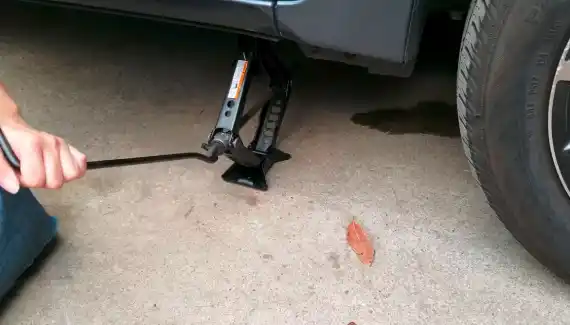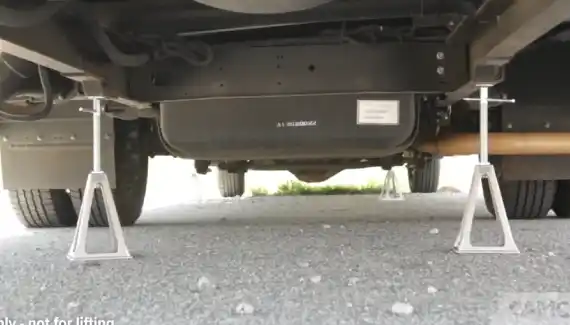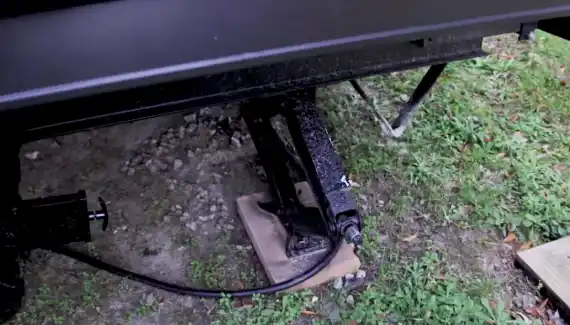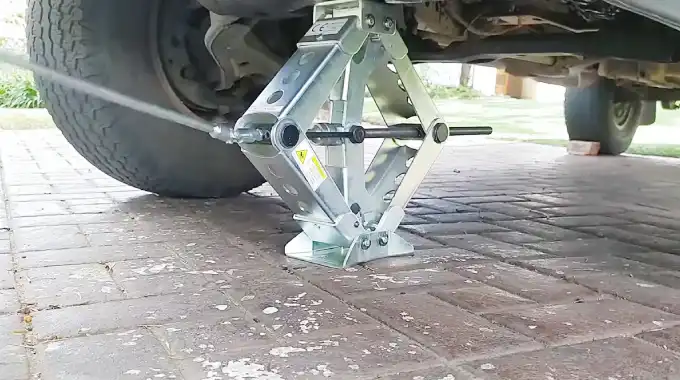Last Updated on April 11, 2023
Have you ever wondered if you can use a car tire jack to lift a camper? It’s totally possible. You just need the right tools and to be super careful with the preparation. But before you go ahead and try it, there are some important steps you need to follow.
You’ll need to locate and prepare the jack, set it up in the right spot, and position it correctly. Secure your camper in place with proper supports and make sure they’re stable before starting to lift. And as always, remember to be safe.
Let us guide you through the journey of completing a task from start to finish. We’ll break down every step so that you can confidently tackle it on your own.
How Can You Lift a Camper With a Car Tire Jack?

If you want to properly lift and balance your car with a tire jack, it can take some time to get used to. But once you get the hang of it, it will give you that extra peace of mind knowing that your camper is safe and set in place.
To get started, follow these steps:
Gather Necessary Supplies
- Car tire jack
- Blocks or boards to provide stability
- Lug wrench or socket set, depending on the type of jack being used
- A Jack stand and wheel chock, if necessary
- Hand Gloves
Step 1: Locate and Prepare the Jack
Before attempting to lift a camper with a car tire jack, you should make sure you have located it in an accessible space. It is important to check the jack for any damages or corrosion. If there is any rust on the jack, you should avoid using it until it has been repaired or replaced.
Also, make sure the pump and handle are attached securely before proceeding. To ensure stability, you should place a wooden block or other sturdy objects underneath the car tire jack when positioning it.
Step 2: Setting Up and Positioning the Jack
For maximum stability once lifted off the ground, don’t place the car tire floor jack too close or too far from any wheel when you’re setting it up and positioning it beneath your camper. This will help prevent any sort of damage from happening to both of them during use.
Aside from that, you’ll want to place the saddle on a safe point of contact on your camper, such as an axle. So that nothing gets stuck between the sections of your car tire jack. When adjusting the height level, keep one hand firmly on either side of the lever to maintain control at all times.
Step 3: Securing the Camper In Place
Once you’ve placed your car tire jack under your camper and got it positioned correctly, lift slowly until all four wheels are off the ground. After they have been lifted up into the air, verify that all four wheels are locked in place using wheel chocks. This will prevent them from moving while you are working beneath them.
If there is an open space between two wheels due to uneven surfaces, then bridge these gaps by placing a board or any other object as an additional support point during this process. If needed, you may also want to use additional car jacks where suitable for extra stabilization.
Despite this, always recheck that both primary and secondary jacks are secured properly before continuing any further work beneath your camper.
Step 4: Finishing Up Once You Are Done Working
Now that we’re done working on the underbody of your car, it’s time to let it back down. Use both levers evenly and make sure no one side goes faster or slower than the other. The goal is to lower it safely and securely until it’s back on ground level without causing any harm or damage in the process.
Carefully remove each wheel chock from around each wheel respectively once all four trailer tires have touched ground level again gently. It is important not to forget about putting away tools, materials, equipment used, securing away proper car tires, etc.
Benefits of Lifting a Camper With a Car Tire Jack

Lifting the camper with a tire jack not only gives you access to the important things beneath it but also provides several advantages.
Here are some of them:
Safety
A car tire jack makes lifting your camper safer than manual labor or outside help, which can cause injuries or damage to your camper. You can be sure that you’ll be able to safely and easily move your camper without any trouble.
Time-Saving
Operating a car tire jack is so much easier and faster than other methods like manual labor or getting help from someone else. You don’t have to do as much work, and all the steps required by the above methods would take away valuable time.
Easy Accessibility
A car tire jack is easy to find as most vehicles come pre-equipped with them as part of their standard package when purchased new from dealerships. This means that you can find an available car tire jack no matter where you are.
Adaptability
If you have a car tire jack, you can use it to lift different types and sizes of campers. It has adjustable settings, so you can control how much pressure is placed on the suspension system when lifting the camper.
Convenience
Using a tire jack to lift your camper is great because it’s so easy to use and access. It doesn’t matter if you’ve never used them before because people who own cars usually know how they work, and there are plenty of resources to help you.
How Big of a Car Tire Jack Do You Need For a Camper?

The size of the car tire jack you need for your camper depends on the tongue weight of your trailer. Generally speaking, you will need at least a 2-ton jack to support the travel trailer. Then again, a 4-ton floor jack is recommended as it takes far less effort to operate and is considered an investment that is well worth making.
A 4-ton jack would be able to handle a wide range of tongue weights with ease and provide much more stability than a smaller model. Suppose you are unsure about how much tongue weight your trailer has.
In that case, it’s best to use the same amount of capacity that’s recommended for that particular trailer type by its manufacturer.
What Happens If You Overload a Car Tire Jack?
Overloading a car tire jack can cause various problems for your vehicle, ranging from minor inconvenience to severe damage.
The following are some potential problems and risks:
Loss of Stabilization
If a car tire jack is overworked, it won’t be able to keep the car stable while you’re lifting it. This can lead to the car jack slipping or collapsing and could result in severe injuries or even death. So it’s important to check that your floor jack isn’t overloaded.
Inability to Lift Vehicle
Overextending the capabilities of your car tire jack will cause it to become stuck under the weight of the truck camper you are attempting to lift.
This can be extremely frustrating since you may need assistance from another person or machinery in order to remove the hydraulic jack from beneath the object.
Oil Leakage
Excessive force may lead to oil leakage from within the components of your car tire stabilizer jacks due to strained seals, brittle components, or broken pieces within its mechanics. This lack of lubrication will affect its performance and output power drastically and must be addressed accordingly.
Damage to Vehicle Structures
Improper loading of a car tire jack can also damage vehicle structures, including brakes, oil pans, drive shafts, fuel tanks, and other suspension components. Therefore it is important to read your vehicle’s manual before using any type of jacking system.
Stress On Internal Components
An overloaded car tire jack exerts extra stress on its own internal components, causing them to wear down faster than usual. Due to excessive stress placed on these components, they may eventually become defective over time, requiring replacement due to damage.
How Do You Stabilize a Car Tire Jack On a Camper?

Stabilizing your car tire jacks on a camper can seem tricky, but it doesn’t have to be. Make sure all four jacks are level with each other, then check that the wheels are chocked so they won’t move or shift when you start jacking them up.
Depending on the type of terrain you’re dealing with: flat surfaces, gravel, loose ground, etc. There may be some additional steps you have to take. But overall, stabilizing your jack is all about ensuring everything stays in place.
Before you load up your trailer with anything, it’s essential to double-check that all nuts and bolts are tightened.
Place sturdy wood or blocks underneath the jacks or travel trailer frame if you intend to use them on uneven terrains such as hills or slopes. This will help prevent the frame from sinking into soft ground when weight is applied.
Where Should a Car Tire Jack Be Used to Jack Up a Camper?
The best place to use a car tire jack when jacking up a camper is under the plate where the U-bolts connect to the axle. This will provide the most secure lifting point and help ensure your camper is lifted evenly.
Further, if there isn’t enough clearance to fit the entire jack under the plate, try positioning it as close to the wheel as possible while still providing enough support for your travel trailer.
Before you attempt any repairs or maintenance on your camper, secure your heavy duty jack in the right place and double-check that both sides are lifted evenly. That way, you can be sure everything is safe and ready for you to work on.
Should You Store a Camper With The Jacks Down?

You don’t necessarily need to store your camper with the jacks down. In any case, if you’re planning on parking it for extended periods of time, then leaving the jacks down is recommended. As this will help prevent them from rusting or getting damaged over time.
It’s also important to release all built-up pressure before placing the travel trailer in storage. This will ensure there aren’t any issues when you come back after an extended period of time.
Conquer Any Camper: Safely Lift with Just a Car Tire Jack
Lifting a camper can be intimidating, but you don’t have to tackle it alone. With the right car tire jack for your specific needs and proper precautions taken, you’ll soon find yourself enjoying all of those camping parks with ease. The size and strength of your jack matter when lifting heavy loads.
Assure you’re prepared to lift it safely off the ground by carefully fastening all components and using a high-quality car tire jack. Smooth sailing awaits. Be sure not to miss any of these essential steps before launching out on highways or dusty trails.
